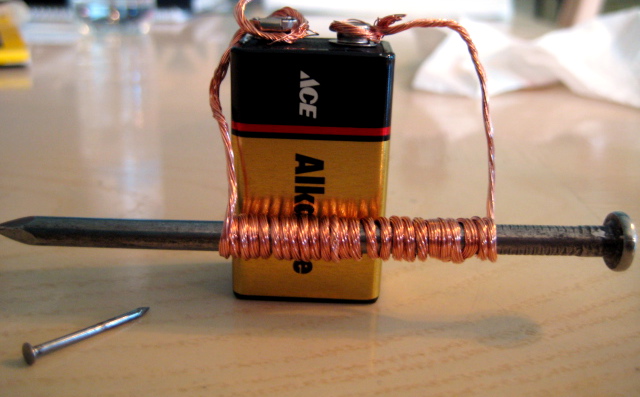Benefits:
We have instant access to information.
We can go shopping without leaving home.
It's easy to contact friends and family all around the world.
Risks:
Viruses can damage computers.
Criminals can access and steal information, products and money.
Long periods of computer use can cause health problems.
People sometimes use the Internet to bully other people.
The information on the Internet isn't always accurate.
Showing posts with label NATURAL. Show all posts
Showing posts with label NATURAL. Show all posts
Wednesday, 25 May 2016
WHAT'S WORD PROCESSING?
Word processing is a type of software. It can be used to type and edit texts such as letters, articles, stories and reports. Some examples are Microsoft Word, Writer, Pages, Apache Open Office...
HOW TO EDIT TEXT IN WORD:
Checking spelling: Words that are spelt incorrectly are underlined in red.
Bold, underline and italics: Highlight the word with the mouse and then click on the bold or italics or underline button in the toolbar.
Creating lists: Highlight the list with your mouse, and then click on the number or bullet point icon in the toolbar.
Cut, copy and paste: To move text, highlight the text with the mouse. Click on the scissors icon to cut it. Then click on the place you want to move it to. Finally, click on the clipboard icon to paste it.
Saving and printing: It's important to save your work regularly. To save a document click on the disc icon in the toolbar. To print it, click on the printer icon.
Changing the font: Select a font from the toolbar.
HOW TO EDIT TEXT IN WORD:
Checking spelling: Words that are spelt incorrectly are underlined in red.
Bold, underline and italics: Highlight the word with the mouse and then click on the bold or italics or underline button in the toolbar.
Creating lists: Highlight the list with your mouse, and then click on the number or bullet point icon in the toolbar.
Cut, copy and paste: To move text, highlight the text with the mouse. Click on the scissors icon to cut it. Then click on the place you want to move it to. Finally, click on the clipboard icon to paste it.
Saving and printing: It's important to save your work regularly. To save a document click on the disc icon in the toolbar. To print it, click on the printer icon.
Changing the font: Select a font from the toolbar.
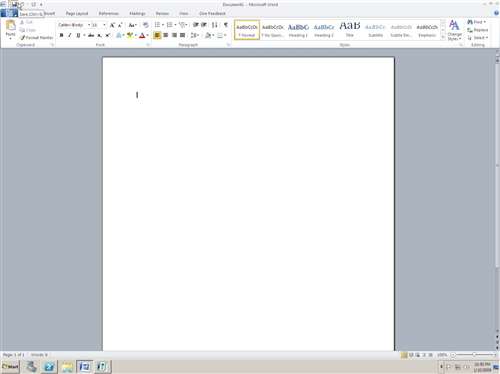 |
| Photo by IvanWalsh via flickr |
Thursday, 19 May 2016
WHAT'S THE INTERNET?
The Internet is a system of computers across the world. These computers are connected to each other in a network.
WHAT'S THE INTERNET USED FOR?
Communication: email, chat rooms, social networks and video-conferencing.
Sharing information: text, images, maps...
Playing games: online and downloadable games.
Banking and shopping.
HOW TO USE THE INTERNET:
What do you need to connect to the Internet? A telephone line, a router, an Internet service provider (ISP), a web browser.
What's a browser? A browser is a computer program that we use to connect to the Internet: Internet Explorer, Chrome, Firefox...
What's a router? A router sends and receives data. By connecting a computer to a router, it can send and receive information from the Internet.
What's an ISP? An ISP is a company that provides access to the Internet (Movistar, Vodafone, Orange...)
WHAT'S THE BEST WAY TO SEARCH FOR INFORMATION ON THE INTERNET?
The Internet has a huge amount of information on many different topics. The best way to find information is to use a search engine (Google, bing, kiddle, bunis...). You introduce a keyword and the search engine gives you a list of links: words or images that take you to web pages with information pages, shopping pages, photos...
WHAT'S THE INTERNET USED FOR?
Communication: email, chat rooms, social networks and video-conferencing.
Sharing information: text, images, maps...
Playing games: online and downloadable games.
Banking and shopping.
HOW TO USE THE INTERNET:
What do you need to connect to the Internet? A telephone line, a router, an Internet service provider (ISP), a web browser.
What's a browser? A browser is a computer program that we use to connect to the Internet: Internet Explorer, Chrome, Firefox...
What's a router? A router sends and receives data. By connecting a computer to a router, it can send and receive information from the Internet.
 |
| Router, By Evan-Amos (Own work) [Public domain], via Wikimedia Commons |
What's an ISP? An ISP is a company that provides access to the Internet (Movistar, Vodafone, Orange...)
WHAT'S THE BEST WAY TO SEARCH FOR INFORMATION ON THE INTERNET?
The Internet has a huge amount of information on many different topics. The best way to find information is to use a search engine (Google, bing, kiddle, bunis...). You introduce a keyword and the search engine gives you a list of links: words or images that take you to web pages with information pages, shopping pages, photos...
HOW DO COMPUTERS WORK?
A computer is a machine that can be programmed with instructions. Computers receive information (input), they carry out a process and they produce output.
HISTORY OF COMPUTERS: The first computer was invented in 1943. It was used to break the codes used by the German army to send messages during World War II. It's name was Colossus because it occupied a whole room.
In 1971, Intel produced the first microprocessor: a very small programmable device. The invention of the microprocessor led to the production of the first household computers.
In the early 1980s, IBM and Apple began producing personal computers or PCs.
TYPES OF COMPUTERS:
General purpose machines: they can perform many functions: mobile phones...
Special purpose machines: they perform one specific function: GPS...
HISTORY OF COMPUTERS: The first computer was invented in 1943. It was used to break the codes used by the German army to send messages during World War II. It's name was Colossus because it occupied a whole room.
 |
| Ian Petticrew [CC BY-SA 2.0 (http://creativecommons.org/licenses/by-sa/2.0)], via Wikimedia Commons |
 |
| By Jamo spingal (Own work) [CC BY 3.0 (http://creativecommons.org/licenses/by/3.0)], via Wikimedia Commons |
 |
| IBM PC 515, By Ruben de Rijcke (Own work) [CC BY-SA 3.0 (http://creativecommons.org/licenses/by-sa/3.0)], via Wikimedia Commons |
TYPES OF COMPUTERS:
General purpose machines: they can perform many functions: mobile phones...
Special purpose machines: they perform one specific function: GPS...
HOW HAVE INVENTIONS CHANGED ART AND MUSIC?
Many artists now use computer software to produce their work. Musicians digitalise music, so they can change the pitch and tone of the music by using modern technology. Digital recording makes it possible to mix different tracks to produce a new version of as ong. Instruments can be added or removed from the recording.
Other artists use modern software and technology to produce digital images. They use stylus and touch-sensitive pads to draw or to edit digital images.
There are many inventions to help us doing exercise: running machines, exercise bikes, rowing machines, heart rate monitors...
_@_The_Cutting_Room_Recording_Studios,_NYC.jpg/640px-SSL_SL9000J_(72ch)_@_The_Cutting_Room_Recording_Studios,_NYC.jpg) |
|
By Rebecca
Wilson (originally posted to Flickr as Vicariously) [CC BY 2.0
(http://creativecommons.org/licenses/by/2.0)], via Wikimedia Commons
|
Other artists use modern software and technology to produce digital images. They use stylus and touch-sensitive pads to draw or to edit digital images.
 |
| Photo via youtube |
There are many inventions to help us doing exercise: running machines, exercise bikes, rowing machines, heart rate monitors...
 |
| By Tomwsulcer (Own work) [CC0], via Wikimedia Commons |
Thursday, 5 May 2016
WHAT INVENTIONS DO WE USE IN OUR DAILY LIVES?
Inventors design machines to solve problems or to make something easier to do.
Modern machines have changed the way we live in many ways:
The bicycle, cars (before the invention of cars we travelled by horse and carriage), steam engine, the hovercraft, aeroplanes...
Modern machines have changed the way we live in many ways:
- Food production: machines have changed the way the food is prepared in large factories, sometimes it has been frozen or packaged in a tin, so it stays fresh for longer periods of time.
- Clothing: most of our clothes contain synthetic fabrics (nylon, viscose). So they're cheaper, more resistant to temperature than natural fabrics and they do not wear out so quickly.
- Healthcare: Doctors use microscopes, computers, X-ray machines and scanners...
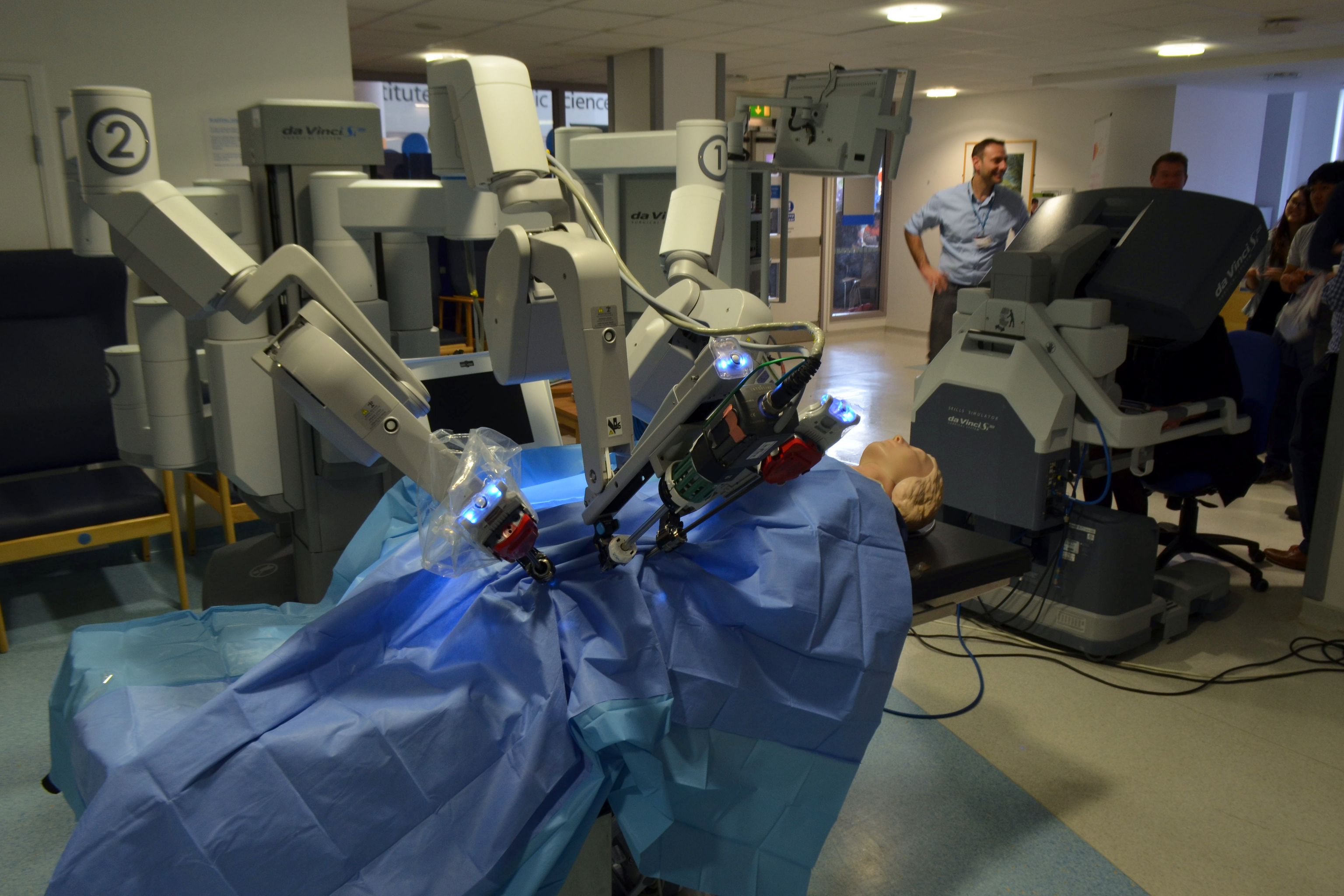
By Cmglee (Own work) [CC BY-SA 3.0 (http://creativecommons.org/licenses/by-sa/3.0) or GFDL (http://www.gnu.org/copyleft/fdl.html)], via Wikimedia Commons
The bicycle, cars (before the invention of cars we travelled by horse and carriage), steam engine, the hovercraft, aeroplanes...
Tuesday, 12 April 2016
HOW ARE ELECTROMAGNETS USED?
Many modern inventions use electromagnets.
ELECTRIC BELL
When the circuit is closed and the current flows through the circuit, it produces a magnetic field in the electromagnet. The hammer is attracted to the elctromagnet and hits the bell. The movement of the hammer breaks the circuit and the hammer returns to its original position. Then the cycle begins again.
MAGLEV
A magnetic levitation train uses electromagnets to levitate above its track.
The maglev has electromagnets in the base of the train.
The tracks have magnets which repel the electromagnets in the train.
The magnets above and in front of the train attract the magnets in the train, causing the train to move forward.
SPEAKERS AND MICROPHONES
Electric current travels through the coil of wire. This creates a magnetic field that switches on and off rapidly.
The magnetic field attracts the magnet, which is attached to the cone.
The cone vibrates rapidly, producing sound waves.
ELECTRIC BELL
When the circuit is closed and the current flows through the circuit, it produces a magnetic field in the electromagnet. The hammer is attracted to the elctromagnet and hits the bell. The movement of the hammer breaks the circuit and the hammer returns to its original position. Then the cycle begins again.
MAGLEV
A magnetic levitation train uses electromagnets to levitate above its track.
The maglev has electromagnets in the base of the train.
The tracks have magnets which repel the electromagnets in the train.
The magnets above and in front of the train attract the magnets in the train, causing the train to move forward.
SPEAKERS AND MICROPHONES
Electric current travels through the coil of wire. This creates a magnetic field that switches on and off rapidly.
The magnetic field attracts the magnet, which is attached to the cone.
The cone vibrates rapidly, producing sound waves.
WHAT ARE THE EFFECTS OF ELECTRICITY?
THERMAL ENERGY
The electric current produces a little thermal energy as it travels through a wire, but it produces a lot of thermal energy travelling through other substances (in an oven...).
CHEMICAL REACTIONS
Electrolysis is a chemical reaction produced when an electric current flows through a liquid solution of charged particles. We use elctrolysis in electroplating: coating a metal object with a thin layer of another metal.
The electric current produces a little thermal energy as it travels through a wire, but it produces a lot of thermal energy travelling through other substances (in an oven...).
| A toaster uses thermal energy from electricity. Nick carson at en.wikipedia [CC BY 3.0 (http://creativecommons.org/licenses/by/3.0)], via Wikimedia Commons |
Electrolysis is a chemical reaction produced when an electric current flows through a liquid solution of charged particles. We use elctrolysis in electroplating: coating a metal object with a thin layer of another metal.
WHAT'S THE EARTH'S MAGNETIC FIELD LIKE?
The Earth has a magnetic field called the magnetosphere. It extends from the South Pole to the North Pole (it's as if the earth had a bar magnet in its centre). The North Pole is the South Pole of the Earth's magnetosphere.
WHAT CAUSES THE MAGNETOSPHERE?
The centre of the Earth is made of liquid iron. This liquid moves slowly as the Earth rotates causing a magnetic field to form around the whole planet.
USING A COMPASS
A compass has a magnetised steel needle that is balanced inside a container. The north pole of the needle is painted red. It is attracted to the south pole of the magnetosphere: the magnetic north pole of the Earth. It will always point north.
WHY IS THE MAGNETOSPHERE IMPORTANT?
It deflects solar radiation from the Sun back into space. Radiation is harmful for plant and animal life on Earth.
It also helps us to navigate using a compass.
 |
| Magnetosphere. By NASA (http://sec.gsfc.nasa.gov/popscise.jpg) [Public domain], via Wikimedia Commons |
WHAT CAUSES THE MAGNETOSPHERE?
The centre of the Earth is made of liquid iron. This liquid moves slowly as the Earth rotates causing a magnetic field to form around the whole planet.
USING A COMPASS
A compass has a magnetised steel needle that is balanced inside a container. The north pole of the needle is painted red. It is attracted to the south pole of the magnetosphere: the magnetic north pole of the Earth. It will always point north.
 |
| Compass. By Evan-Amos (Own work) [Public domain], via Wikimedia Commons |
WHY IS THE MAGNETOSPHERE IMPORTANT?
It deflects solar radiation from the Sun back into space. Radiation is harmful for plant and animal life on Earth.
It also helps us to navigate using a compass.
WHAT'S A BAR MAGNET?
Bar magnets are permanent magnets, they can't be switched on and off, they always have a magnetic field. They have two poles: north (positively charged) and south (negatively charged). They attract metals such as iron, steel, cobalt and nickel. They also attract and repel other magnets.
WHAT DOES A MAGNETIC FIELD LOOK LIKE?
We can see the magnetic field of a bar magnet using iron filings.
HOW DO WE REPRESENT MAGNETIC FIELDS?
We draw lines from the north pole to the south pole of the magnet. There are more lines and they're closer together near the poles because the magnetic field is stronger there.
WHAT HAPPENS WHEN TWO MAGNETS ATTRACT OR REPEL EACH OTHER?
Look at the pictures:
HOW CAN WE IDENTIFY A MAGNET?
Magnets repel other magnets, but they don´t repel other substances.
 |
| Bar magnet. Photo taken by Aney, 2006-03-12, GFDL via Wikimedia |
WHAT DOES A MAGNETIC FIELD LOOK LIKE?
We can see the magnetic field of a bar magnet using iron filings.
 |
| By Alexander Wilmer Duff [Public domain], via Wikimedia Commons |
HOW DO WE REPRESENT MAGNETIC FIELDS?
We draw lines from the north pole to the south pole of the magnet. There are more lines and they're closer together near the poles because the magnetic field is stronger there.
WHAT HAPPENS WHEN TWO MAGNETS ATTRACT OR REPEL EACH OTHER?
Look at the pictures:
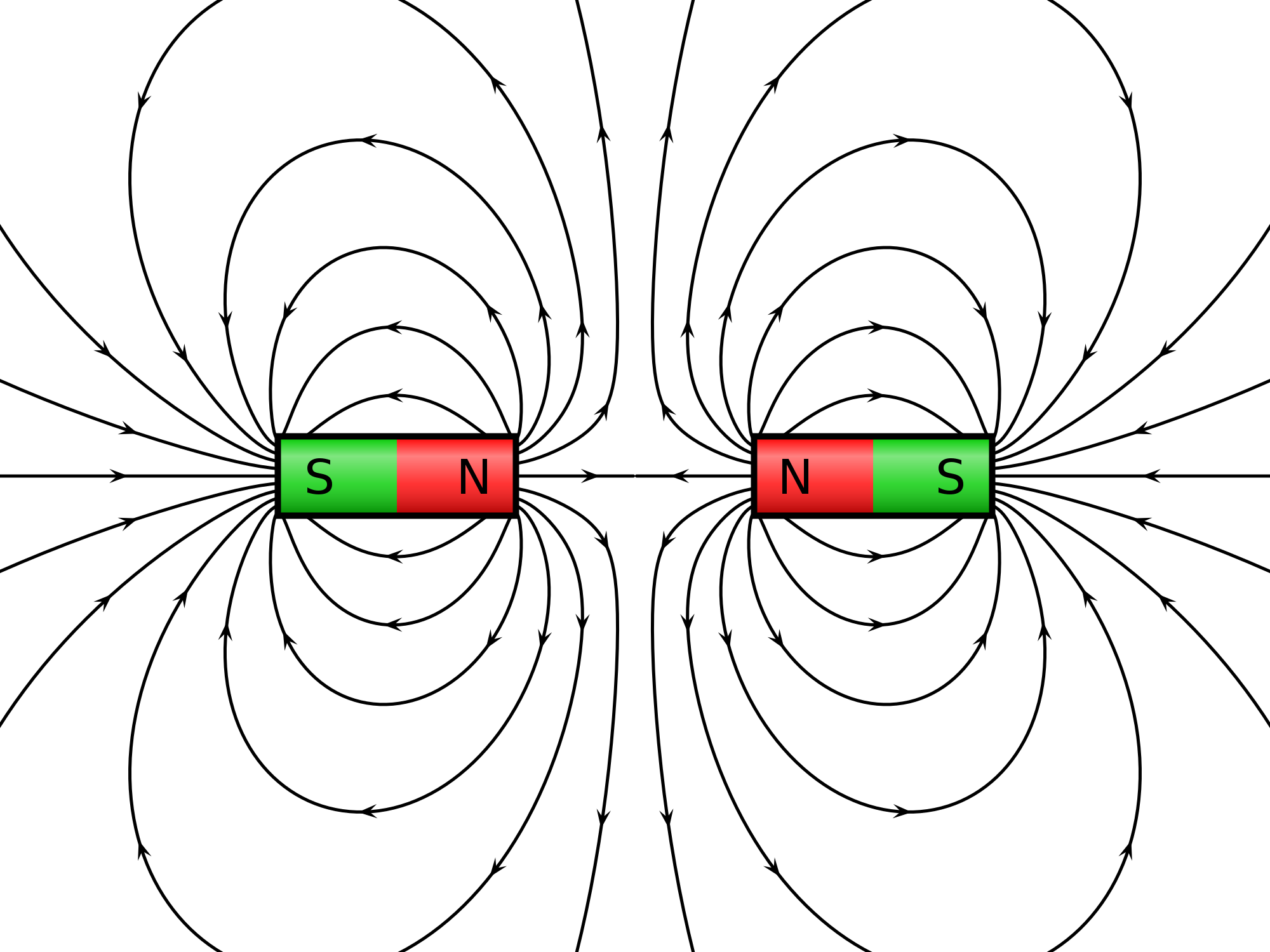 |
| Two magnets repelling. By Geek3 [GFDL (http://www.gnu.org/copyleft/fdl.html) or CC BY-SA 3.0 (http://creativecommons.org/licenses/by-sa/3.0)], via Wikimedia Commons |
 |
| Two magnets attracting. By Geek3 [GFDL (http://www.gnu.org/copyleft/fdl.html) or CC BY-SA 3.0 (http://creativecommons.org/licenses/by-sa/3.0)], via Wikimedia Commons |
HOW CAN WE IDENTIFY A MAGNET?
Magnets repel other magnets, but they don´t repel other substances.
HOW WAS ELECTROMAGNETISM DISCOVERED?
Hans Christian Oersted discovered that electric current produces a magnetic force. Oersted saw that an electric circuit switched on made the compass needle move, but he couldn't explain the phenomenon.
André-Marie Ampere decided to study that phenomenon. He discovered the electron, which produces both, electricity and magnetism. But he named it the 'electrodynamic molecule'. Later, other scientists named it the electron.
Michael Faraday discovered that by moving a loop of wire over a magnet, an electric current was produced in the wire. He invented the 'electromagnetic rotary device', the basis for the first electric motor or dynamo.
SEPARATING MIXTURES WITH MAGNETS
Electromagnets are made from a wire coiled around an iron rod. The wire is connected to a power source. When the electric current flows along the wire a magnetic field is generated. When you stop the circuit, the electromagnet is switched off. Electromagnets are used in recycling plants to separate iron and steel from plastic, glass or other metals.
 |
| Picture from wikimedia |
André-Marie Ampere decided to study that phenomenon. He discovered the electron, which produces both, electricity and magnetism. But he named it the 'electrodynamic molecule'. Later, other scientists named it the electron.
 |
| By Ambrose Tardieu [Public domain], via Wikimedia Commons |
Michael Faraday discovered that by moving a loop of wire over a magnet, an electric current was produced in the wire. He invented the 'electromagnetic rotary device', the basis for the first electric motor or dynamo.
 |
| By Probably albumen carte-de-visite by John Watkins [Public domain], via Wikimedia Commons |
 |
| Faraday Disk Generator. By Émile Alglave [Public domain], via Wikimedia Commons |
SEPARATING MIXTURES WITH MAGNETS
Electromagnets are made from a wire coiled around an iron rod. The wire is connected to a power source. When the electric current flows along the wire a magnetic field is generated. When you stop the circuit, the electromagnet is switched off. Electromagnets are used in recycling plants to separate iron and steel from plastic, glass or other metals.
Saturday, 5 March 2016
WHAT'S OXIDATION?
Oxidation is a chemical reaction in which an atom loses one or more electrons to oxygen atoms. Oxidation causes changes to the properties and appearance of substances.
Types of oxydation:
Rusting: When iron is exposed to oxygen in the air, its electrons are lost. Rusting can cause problems in vehicles. To prevent this, vehicles are painted.
Oxidation in fruit: When the fruit is exposed to the air, its electrons are lost. When this happens, a chemical change takes place, and the part of the fruit that has oxidised is no longer good to eat.
Fermentation: is a chemical reaction in which an organism such as yeast or bacteria, changes sugar and carbohydrates into alcohol or an acid.
Types of oxydation:
Rusting: When iron is exposed to oxygen in the air, its electrons are lost. Rusting can cause problems in vehicles. To prevent this, vehicles are painted.
Oxidation in fruit: When the fruit is exposed to the air, its electrons are lost. When this happens, a chemical change takes place, and the part of the fruit that has oxidised is no longer good to eat.
Fermentation: is a chemical reaction in which an organism such as yeast or bacteria, changes sugar and carbohydrates into alcohol or an acid.
Thursday, 3 March 2016
WHAT ARE CHEMICAL CHANGES?
Chemical changes occur when one or more substances combine to form a new substance. A chemical change is non-reversible.
The process in which two or more substances combine chemically is called a chemical reaction.
Some chemical reactions produce thermal energy; these are called exothermic reactions.
Other reactions absorb thermal energy; these are called endothermic reactions.
Combustion, or burning, is the name for a chemical reaction in which oxygen combines with a fuel, such as wood, coal or natural gas. It is an exothermic reaction.
We use combustion in various ways:
 |
| Image from sjesci |
Some chemical reactions produce thermal energy; these are called exothermic reactions.
Other reactions absorb thermal energy; these are called endothermic reactions.
Combustion, or burning, is the name for a chemical reaction in which oxygen combines with a fuel, such as wood, coal or natural gas. It is an exothermic reaction.
We use combustion in various ways:
- Petrol and diesel are burnt to power vehicles and to heat homes.
- Coal is burnt in power stations to generate electricity.
- We burn natural gas to cook and heat our homes.
- Most fuels produce carbon dioxide during combustion. Carbon dioxide contributes to global warming.
- Burning coal, petrol or diesel produce particles that pollute the air.
- Burning coal and diesel can produce an acid called sulphur dioxide. If sulphur dioxide mixes with rainwater, it produces acid rain.
Tuesday, 1 March 2016
HOW ARE MIXTURES SEPARATED?
Mixtures can be separated into their original components (because the components haven't been chemically combined). Several techniques can be used to separate mixtures: for example, filtration, distillation, evaporation or dissolution.
Filtration: This technique can be used to separate an insoluble solid from a mixture.
Evaporation: This technique can be used to separate a soluble solid from a solution.
Distillation: This technique can be used to separate a liquid from a solution or to separate two liquids.
Dissolution: This technique can be used to separate a soluble solid from an insoluble one.
Filtration: This technique can be used to separate an insoluble solid from a mixture.
 |
| Picture via eschooltoday |
 |
| Photo via bbc.co.uk |
 |
| Photo via bbc.co.uk |
 |
| Photo via bbc.co.uk |
Distillation: This technique can be used to separate a liquid from a solution or to separate two liquids.
Dissolution: This technique can be used to separate a soluble solid from an insoluble one.
Monday, 29 February 2016
WHAT IS A MIXTURE?
A mixture is a substance made up of two or more types of matter that aren't chemically combined.
There are two types of mixtures:
Homogeneous mixtures: It is a mixture that has a consistent color and texture. Every part of an homogeneous mixture has the same properties.
Heterogeneous mixture: It is a mixture that has a varied color or texture. Each substance in the mixture retains its specific properties.
solution is a mixture of one or more liquids, with one or more other substances. In a solution, the substances are dissolved in the liquid.
The liquid components of a solution are called solvents. The other components are called solutes.
There are two types of mixtures:
Homogeneous mixtures: It is a mixture that has a consistent color and texture. Every part of an homogeneous mixture has the same properties.
 |
| Homogeneous mixture Fondant au Chocolat. Photo by Ly. H via flickr |
solution is a mixture of one or more liquids, with one or more other substances. In a solution, the substances are dissolved in the liquid.
The liquid components of a solution are called solvents. The other components are called solutes.
Saturday, 27 February 2016
WHAT ARE THE BASIC LAWS OF REFLECTION?
Light is a form of energy that travels in waves.
Matter that is in a gaseous state is usually transparent: it doesn't reflect light.
Matter that is liquid usually has a smooth reflective surface.
Solid matter usually has a rougher surface than liquid, so it reflects light but they don't produce a reflection.
REFLECTION AND DIFFUSION:
When light hits a smooth surface, it's reflected regularly.
When light hits a rough surface, it's reflected irregularly. This is called diffusion.
ELECTRICITY:
All matter is made up of atoms. Each atom consists of protons, neutrons and one or more electrons.
When atoms lose electrons, matter becomes positively charged.
When atoms gain electrons, matter becomes negatively charged.
Matter that is in a gaseous state is usually transparent: it doesn't reflect light.
Matter that is liquid usually has a smooth reflective surface.
Solid matter usually has a rougher surface than liquid, so it reflects light but they don't produce a reflection.
REFLECTION AND DIFFUSION:
When light hits a smooth surface, it's reflected regularly.
 |
| Image from https://www.orcagrowfilm.com/Articles.asp?ID=148 |
 |
| Image from https://www.orcagrowfilm.com/Articles.asp?ID=148 |
ELECTRICITY:
All matter is made up of atoms. Each atom consists of protons, neutrons and one or more electrons.
When atoms lose electrons, matter becomes positively charged.
When atoms gain electrons, matter becomes negatively charged.
Thursday, 4 February 2016
MEDICAL ADVANCES HELP REPRODUCTION
Medical advances can help at specific stages of reproduction.
Fertilisation: In-vitro fertilisation is a procedure that involves joining the male and female reproductive cells outside the woman's body, in a laboratory. If fertilisation occurs, the zygote is placed inside the woman's uterus.
Birth: one of the problems which can occur during birth is the breech birth, doctors usually perform a Cesarean section. They extract the fetus through a small cut they open through the lower abdomen and the wall of the uterus, instead of through the mother's vagina.
Pregnancy: during pregnancy specialist doctors check the mother and the fetus health. They analyse blood and urine samples to detect infections in the fetus. To detect problems (abnormalities) in the fetus, doctors analyse amniotic fluid extracted from the amniotic sac. This procedure is known as amniocentesis. They also use an ultrasound scan to check the developing organs and bones in the fetus and its growth as well.
Fertilisation: In-vitro fertilisation is a procedure that involves joining the male and female reproductive cells outside the woman's body, in a laboratory. If fertilisation occurs, the zygote is placed inside the woman's uterus.
Birth: one of the problems which can occur during birth is the breech birth, doctors usually perform a Cesarean section. They extract the fetus through a small cut they open through the lower abdomen and the wall of the uterus, instead of through the mother's vagina.
 |
| Click on this photo to watch a video about Cesarean Section. |
Tuesday, 2 February 2016
FERTILISATION
FERTILISATION
A man and a woman have sexual intercourse. The man deposits his semen in the woman's vagina. The sperm cells swim into the uterus and up the fallopian tubes, where one of them will fertilise the female egg cell. When a sperm cell joins with an egg cell in the fallopian tube, they form
a new cell called a zygote (click here to watch a video about fertilisation). The zygote that results goes into the uterus. as it travels, it divides many times to form a group of cells called an embryo, and finally it develops into a fetus.
 |
| Zygote at the eight cell stage. Via bbc.co.uk |
 |
| 8 cell embryo at day 3. By ekem, Courtesy: RWJMS IVF Program [Public domain], via Wikimedia Commons. |
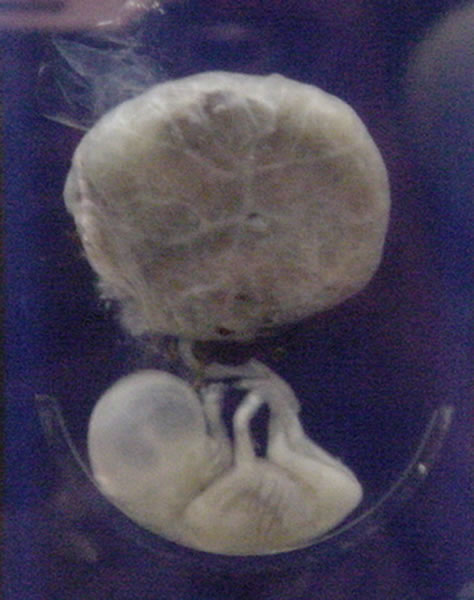 |
| Fetus 3 months. By National Museum of Health and Medicine [Public domain], via Wikimedia Commons. |
PREGNANCY
Pregnancy is the period of time between the fertilisation of an egg cell and the birth of a baby.
The placenta provides the fetus with oxygen and nutrients from the mother's blood. It also takes away carbon dioxide and waste that the fetus produces.
The fetus is connected to the placenta by the umbilical cord.
The amniotic sac contains a liquid called amniotic fluid. This liquid supports
the fetus and protects it.
 |
| Fetus in the amniotic sac, via howitworksdaily.com |
WHAT HAPPENS DURING BIRTH?
During birth (click on the word birth to watch a video) the walls of the uterus start to contract.
Then the cervix gets wider to enable baby to come out of the uterus. Next the
amniotic sac breaks and the contractions push the baby into the vaginal canal.
Once the baby is outside the mother's body he starts to breathe and the doctor cuts the umbilical cord. Finally the amniotic sac, the placenta and the rest of the umbilical cord are expelled.
THE MALE REPRODUCTIVE SYSTEM
The foreskin is a fold of skin that covers the end of the penis
The
testicles produce sperm cells. They are suspended inside a bag of skin called the scrotum.
The vas deferens is a tube which sperm cells travel
through from the testicles to the seminal vesicles, the prostate and the
urethra.
The seminal vesicles produce a liquid
that becomes part of the semen.
The prostate produces a white liquid.
This liquid makes up the semen.
The urethra is a tube that goes from
the bladder through the prostate, and out the end of the penis. The urethra
carries both semen and urine out of the body.
The penis is an elastic organ. The end of the penis is called the glans.
 |
| Male Reproductive System. Via mayoclinic.org. |
 |
| Male Reproductive System. Via humananatomybody.info |
1.- First, sperm cells are produced inside the testicles.
2.- Then the vas deferens transport sperm cells from the testicles to the seminal vesicles.
3.- Next, the sperm cells are transported through the prostate into the urethra.
4.- Finally the semen travels through the urethra and out of the penis. This process is called ejaculation.
Subscribe to:
Posts (Atom)


